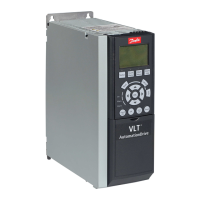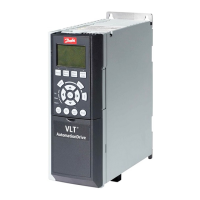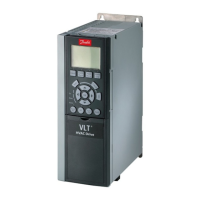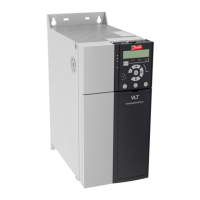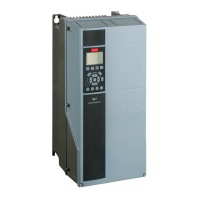7-31 Process PID Anti Windup
Option: Function:
[0] Off Ceases regulation of an error when the output frequency can no longer be adjusted.
[1] * On Continues regulation of an error even when the output frequency cannot be increased or decreased.
7-32 Process PID Start Speed
Range: Function:
0 RPM* [0 - 6000 RPM] Enter the motor speed to be attained as a start signal for commencement of PID control. When the
power is switched on, the frequency converter will commence ramping and then operate under
speed open loop control. Thereafter, when the Process PID start speed is reached, the frequency
converter will change over to Process PID control.
7-33 Process PID Proportional Gain
Range: Function:
0.01* [0.00 - 10.00 ] Enter the PID proportional gain. The proportional gain multiplies the error between the set point
and the feedback signal.
7-34 Process PID Integral Time
Range: Function:
10000.00
s*
[0.01 - 10000.00 s] Enter the PID integral time. The integrator provides an increasing gain at a constant error between
the set point and the feedback signal. The integral time is the time needed by the integrator to reach
the same gain as the proportional gain.
7-35 Process PID Differentiation Time
Range: Function:
0.00 s* [0.00 - 10.00 s] Enter the PID differentiation time. The differentiator does not react to a constant error, but provides
a gain only when the error changes. The shorter the PID differentiation time, the stronger the gain
from the differentiator.
7-36 Process PID Diff. Gain Limit
Range: Function:
5.0* [1.0 - 50.0 ] Enter a limit for the differentiator gain (DG). If there is no limit, the DG will increase when there are
fast changes. Limit the DG to obtain a pure differentiator gain at slow changes and a constant
differentiator gain where fast changes occur.
7-38 Process PID Feed Forward Factor
Range: Function:
0 %* [0 - 200 %] Enter the PID feed forward (FF) factor. The FF factor sends a constant fraction of the reference
signal to bypass the PID control, so the PID control only affects the remaining fraction of the control
signal. Any change to this parameter will thus affect the motor speed. When the FF factor is activated
it provides less overshoot, and high dynamics when changing the set point. par. 7-38
Process PID
Feed Forward Factor
is active when par. 1-00
Configuration Mode
is set to [3] Process.
7-39 On Reference Bandwidth
Range: Function:
5 %* [0 - 200 %] Enter the On Reference bandwidth. When the PID Control Error (the difference between the refer-
ence and the feedback) is less than the set value of this parameter the On Reference status bit is
high, i.e. =1.
3 Parameter descriptions FC 300 Programming Guide
132
MG.33.M8.02 - VLT
®
is a registered Danfoss trademark
3
